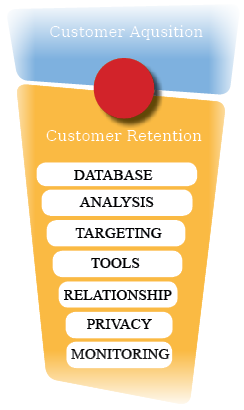| Title: | A Framework for Customer Relationship Management |
| Status: | Have read |
| Author: | Russel S Winer |
| Source: | California Management Review; Summer2001, Vol. 43 Issue 4, p89-105, 17p, 4 diagrams |
| Keyword: | Customer Relationship Management+ |
| Citation: | Winer, 2001+ |
| Russel S Winer, (2001) “A Framework for Customer Relationship Management“, California Management Review; Summer2001, Vol. 43 Issue 4, p89-105, 17p, 4 diagrams BibTeX, Scholar |
Russel Winer in his article A Framework for Customer Relationship Management (published in the California Management Review, Vol. 43 Issue 4) described a framework on how a company should look on CRM when confronted with building a more closer relationship with its customer.
He underlines that, the first thing to understand is the process and its limition and then try to find a technology that suits this process best but not the other way around.
Article Summary
The article uses widely the web/email interface as case study material to show examples on how to improve and facilitate better customer relationships.
In order to strengthen the relationship with a customer it is important to directly respond to customer requests and create interactive customer response process (customized experience).
The web-“interface” is a method to reduce service cost where at the same time the response level (quality etc.) and response frequency can be increased.
An IDC is used to show the growth potential within the CRM product and service area where the need to “understand customer behaviour and the interest” should be the prior objective and not the collection of data.
While looking at CRM, a company need to change its mindset in order shift from an acquisition to a retention culture. He uses a McKinsey study and Reichheld to show that a small increase in customer retention will lead up to a extra proportional increase in customer gross income.
In order to monitor a broader customer profitability, the analysis should focus on customer centered metrics that are divided into three categories such as attraction, conversion and retention.
Building relationship means to increase interaction that allow a reactive and proactive customer response process to “read” the customer needs and to filter and collect customer information.
The Model

Customer Relationship Management Model (Winer 2001)
Database and database structure to gather information such as transaction, contacts, descriptive and response information.
Analysis such as discriminant or clickstream analysis is used to cluster and identify behavioral pattern but further to allow to create a “1-to-1” response scheme for individual customers to drill down onto the lifetime customer value (LCV) analysis.
Target Decision (Selection process + Targeting) are made to focus on the most profitable customers due to their individual LCV and divided customers into long-term and short-term supporter.
Tactical Tool Decision as a portfolio to foster response frequency and identify preferred methods of interaction to allow a continuous relationship bonding.
Relationship Management is seen as to maintain and constant monitoring of customer satisfaction that involves customer service (reactive and proactive customer response process) , reward and loyalty programs (increase switching cost and entry barriers), customization (conversion from product takers into product makers) and community (personalization and identification) efforts.
Privacy needs to be addressed (opt-in and opt-out) in order to maintain a trust level with a customer but still be able to gather information that makes it possible to enhance a companies knowledge base and it’s relationship program.
Metrics and Monitoring need to be customer centric in order to monitor on an individual level as the core capability to guide a successful CRM process.
Structure and Execution
As product management and customer service uses distinct capabilities in creating customer acquisitions and customer retention.
He suggest that structural adoption is necessary for companies that want to lead a CRM based process, so that organizational elements help strengthen the execution of this strategy by recognizing the difference in its process skills.
Reference
Winer, R.S. (2001), A framework for customer relationship management, California Management Review, Volume: 43; Issue: 4; Page: 89-105

You must be logged in to post a comment.